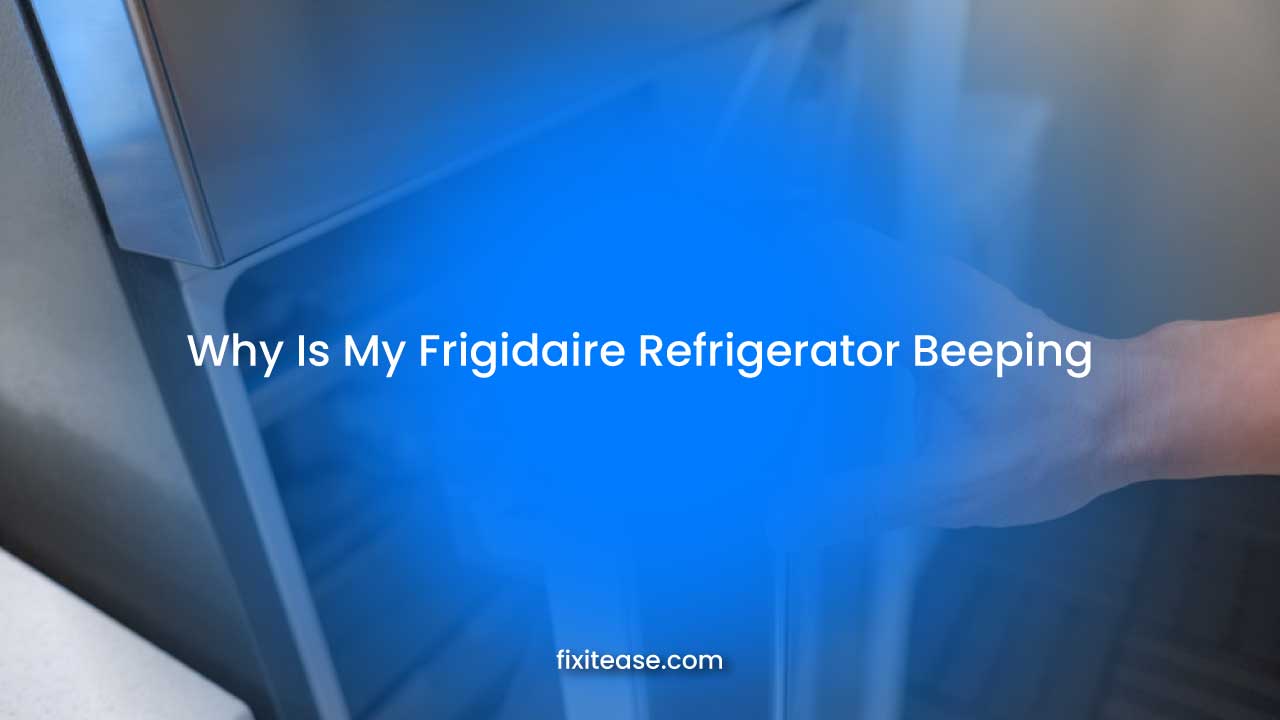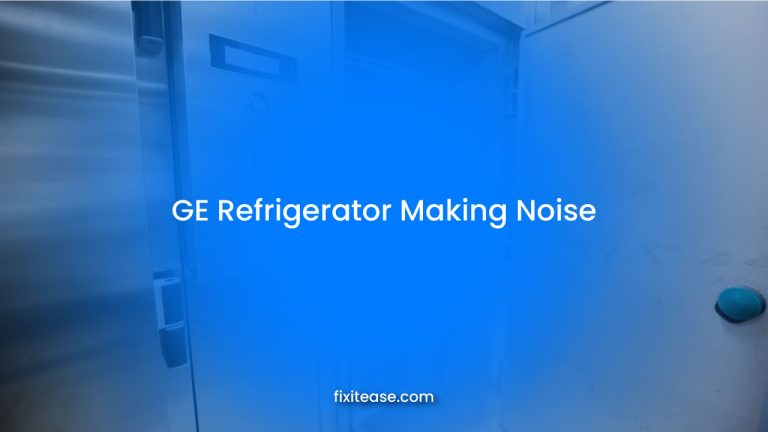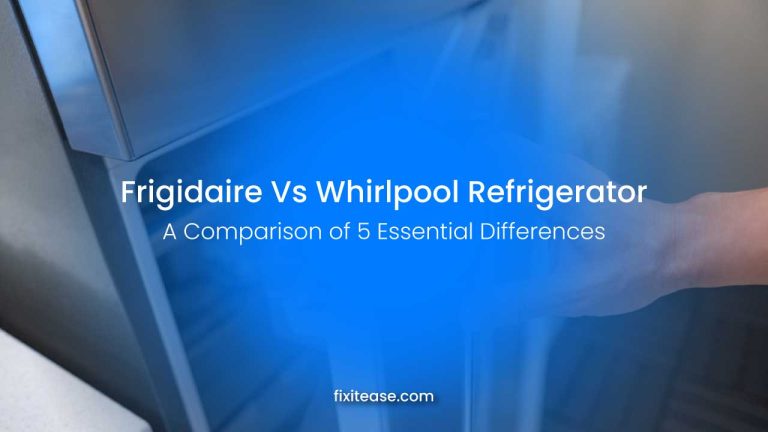Why Is My Frigidaire Refrigerator Beeping? 5 Reasons and Fixes
Sometimes, refrigerators produce different sounds like humming, buzzing, beeping, and so on. Some of the sounds are usual and they don’t mean something harmful but the beeping part is different, it means your refrigerator needs quick attention. So, why is your Frigidaire refrigerator beeping?
There could be several reasons such as too high temperature, a faulty door switch, blocked air vents, power failure, defective door seals, too many or too few food items in the refrigerator, and some others. You can notice visual error codes like H, and H1 on your refrigerator along with the beeping noise.
Let’s go through the full article to know more details about the topic.
5 Reasons Why Your Frigidaire Refrigerator Is Beeping
Below we’ll be sharing the common reasons that cause your Frigidaire refrigerator beeping. You’ll get the solutions too.

1. Too High Temperature
“Too High Temperature” in a Frigidaire refrigerator indicates that the internal temperature has risen above the recommended limit, which is typically 55 degrees Fahrenheit (13°C) for the fridge and 26 degrees Fahrenheit (-3°C) for the freezer.
If the temperature exceeds these limits, it can lead to food spoilage, loss of freshness, and potential health hazards, as bacteria can multiply rapidly in warmer conditions.
How to Identify It
- Inconsistent Cooling: One of the first signs of a too-high temperature issue is an inconsistent cooling performance. Your fridge may not keep your food and beverages as cold as they should be, potentially leading to spoilage.
- Digital Display: The digital display on your Frigidaire refrigerator will likely show the “Too High Temperature” warning, often accompanied by a flashing temperature reading that exceeds the desired range.
- Warm Air: When you open the fridge or freezer doors, you may notice warm air escaping, indicating that the internal temperature is too high.
How to Fix It:
- Check the Thermistor: If the thermistor is faulty, it should be replaced. Consult your refrigerator’s user manual for specific instructions or consider contacting a professional technician for this task.
- Ensure Proper Airflow: Organize the items in your fridge to allow for adequate airflow. Keep vents unobstructed and don’t overload the shelves, ensuring air can circulate freely.
- Clean the Condenser Coils: Regularly clean the condenser coils to remove dust and debris. Use a vacuum cleaner or a brush to maintain optimal cooling efficiency.
- Compressor Examination: If you suspect the compressor is faulty, it’s best to contact a certified technician. Replacing a compressor is a complex task that requires specialized knowledge and tools.
2. A Power Failure
The right power supply to your refrigerator is crucial because it keeps the appliance running, maintaining proper cooling and food preservation. When the power fails, the refrigerator stops working, risking food spoilage and the potential loss of stored items. It’s essential to ensure a reliable power source to prevent these issues.
How to Identify It
- Display Message: Your Frigidaire refrigerator’s digital display will explicitly show the message “A POWER FAILURE.” It indicates that the appliance has experienced a power interruption.
- Clock Reset: If your refrigerator has a built-in clock or timer, you may notice that it has reset to 12:00 or a default time. This is another sign of a power failure event.
- Loss of Cooling: In some cases, you might observe a temporary loss of cooling performance after a power failure, as the appliance needs time to regain its optimal temperature.
How to Fix It
- Check for External Power Issues: When you encounter this error, start by confirming if there is a power outage in your area. If not, check the circuit breaker in your home to ensure it hasn’t tripped. Additionally, verify that the refrigerator is securely plugged into a functioning outlet.
- Replace Damaged Power Cord: If you find that the power cord is damaged, replace it with a new one. Ensure the replacement cord is compatible with your refrigerator’s specifications.
- Reduce Electrical Load: To prevent circuit overloads, consider moving other appliances to different circuits. Refrigerators should ideally have a dedicated circuit to avoid power interruptions.
- Consider a Surge Protector: Installing a surge protector can help safeguard your refrigerator from power fluctuations and prevent “A POWER FAILURE” messages during voltage spikes.
3. Air Vents Are Blocked
Clear air vents are a must for maintaining even cooling. When blocked, it leads to temperature inconsistencies, making some areas too cold and others too warm. Proper ventilation is essential to prevent food spoilage and ensure efficient refrigeration.
How to Identify It
- Temperature Fluctuations: One of the primary signs is noticeable temperature variations within the refrigerator. Some areas may be too cold, while others are too warm.
- Restricted Airflow: When you open the fridge or freezer, you might feel cold air in some areas and warmer air in others. This indicates uneven airflow caused by blocked vents.
- Ice Buildup: In the freezer section, you might notice excessive ice formation on the walls or shelves, which can obstruct the airflow.
How to Fix It
- Reorganize Overcrowd Shelves: Ensure that your shelves are not overcrowded, and items are not placed too close to the air vents. Proper organization allows for better airflow and consistent cooling.
- Regular Defrosting: If you notice ice buildup in the freezer, defrost it regularly to prevent blockages. Transfer frozen items to a temporary storage location and allow the ice to melt naturally or use a fan to expedite the process.
- Proper Food Storage: Store food in airtight containers to prevent spills and leaks that can lead to ice formation and blockage. Use clear containers to easily identify and access items.
- Check and Replace Door Gaskets: Inspect the door gaskets for any wear or damage. If necessary, replace them to ensure a tight seal, preventing warm air infiltration.
4. Faulty Door Switch
Before speaking of a faulty door switch, here’s what a door switch does in your refrigerator.
It triggers the interior light ensuring that the door is securely closed, and prevents cold air from escaping. If the door switch is faulty, it can lead to issues like the interior light not working correctly, false door ajar alarms, and inefficient cooling due to air leakage. Fixing a faulty door switch is essential to maintain proper refrigerator operation and prevent unnecessary problems.
How to Identify It
- Interior Light Issues: The refrigerator’s interior light doesn’t turn on when you open the door, or it remains lit even when the door is closed.
- Alarm Activation: The door ajar alarm sounds, indicating that the fridge thinks the door is not properly closed when it is.
- Digital Display Warning: The digital display may show a message like “Faulty Door Switch” or “Door Open” when the door is securely closed.
How to Fix It
- Inspect the Door Switch: Carefully examine the door switch for any visible damage or signs of wear. If damaged, replace it with a compatible replacement part, following your refrigerator’s user manual.
- Check Wiring Connections: Make sure that the wiring connecting the door switch is secure and undamaged. Repair or replace any faulty wiring to restore proper functionality.
- Clean the Door Switch Area: If you notice any dirt, debris, or food particles around the door switch, remove them thoroughly. A gentle cleaning with a soft brush or compressed air can help ensure it functions smoothly.
- Reset the Refrigerator: After fixing or replacing the door switch, reset the refrigerator by unplugging it from the power source for a few minutes and then plugging it back in. This can often clear error messages and restore normal operation.
5. Defective Door Seals
Door seals create an airtight barrier, keeping cold air in and warm air out. If they are faulty, the refrigerator loses its ability to maintain consistent temperatures which leads to energy inefficiency, food spoilage, and potential moisture issues.
How to Identify It
- Visual Inspection: Examine the rubber gaskets around the refrigerator and freezer doors. Look for visible cracks, tears, or areas where the seal is not flush against the door.
- Dollar Bill Test: Place a dollar bill or a piece of paper between the closed door and the gasket. If you can easily pull it out without resistance, the seal may be defective.
- Temperature Fluctuations: If the door seals are compromised, your refrigerator may struggle to maintain consistent temperatures, leading to food spoilage and increased energy consumption.
How to Fix It
- Replace the Seals: If you notice significant damage or deterioration, it’s best to replace the defective door seals. Contact the manufacturer or an authorized service technician for the correct replacement parts and installation.
- Clean and Maintain: Regularly clean the door seals with mild soap and water. Ensure they are free of debris and food residues that can affect their performance.
- Proper Door Closing: Train yourself and other users to close the doors gently but firmly, avoiding excessive force that can damage the seals.
- Use Seal Lubricants: Some specialized seal lubricants can help maintain the flexibility of the gaskets. Follow the manufacturer’s recommendations when applying these products.
However, these are not the only reasons for your refrigerator to beep or make any other noise. If your refrigerator has too many or too few food items in it, if the door is not closed properly, and if the control board is faulty somehow, the beeping issue can arise.
FAQs
Why is my Frigidaire refrigerator beeping H1?
Your Frigidaire refrigerator is beeping with the H1 code due to a temperature issue. H1 signifies that the freezer or refrigerator compartments are too warm.
Several factors can cause this, including a faulty thermostat, compressor problems, blocked vents, or a refrigerant leak. If you’re not sure about what’s causing it and how to fix it, seek professional repair to prevent food spoilage and maintain the appliance’s performance.
Why is my Frigidaire refrigerator making a loud humming noise?
A loud humming noise in your Frigidaire refrigerator is typically due to the appliance’s compressor and condenser fan running. In most cases, you don’t have to worry because it’s a normal operational sound.
However, if the noise is unusually loud, it may indicate an issue with these components or an obstructed airflow. Regular cleaning, ensuring proper levelling, and addressing any loose or damaged parts can help reduce the noise.
Last Words
Finally, we’re about to end the discussion. We’ve explored the common reasons behind your Frigidaire refrigerator beeping.
You already know that the reason behind a beeping noise in your refrigerator can indicate different malfunctions such as defective door seals, a faulty control board, power issues, and so on. Although we’ve guided you with some effective solutions, you should consult a professional technician if you’re not experienced with DIY projects.







